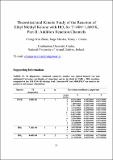| dc.contributor.author | Zhou, Chong-Wen | |
| dc.contributor.author | Mendes, Jorge | |
| dc.contributor.author | Curran, Henry J. | |
| dc.date.accessioned | 2013-05-09T16:38:51Z | |
| dc.date.available | 2013-05-09T16:38:51Z | |
| dc.date.issued | 2013 | |
| dc.identifier.citation | Zhou, Chong-Wen, Mendes, Jorge, & Curran, Henry J. (2013). Theoretical and Kinetic Study of the Reaction of Ethyl Methyl Ketone with HȮ2 for T = 600–1600 K. Part II: Addition Reaction Channels. The Journal of Physical Chemistry A, 117(22), 4526-4533. doi: 10.1021/jp3128127 | en_US |
| dc.identifier.uri | http://hdl.handle.net/10379/3412 | |
| dc.description.abstract | The temperature and pressure dependence of the addition reaction of ethyl methyl ketone (EMK) with HO2 radical has been calculated with the master equation method employing conventional transition state theory estimates for the microcanonical rate coefficients in the temperature range of 600-1600 K. Geometries, frequencies, and hindrance potentials were obtained at the B3LYP/6-311G(d,p) level of theory. A modified G3(MP2,CC) method has been used to calculate accurate electronic energies for all of the species involved in the reactions. The rigid-rotor harmonic oscillator approximation has been used for all of the vibrations except for the torsional degrees of freedom which are being treated as 1D hindered rotor. Asymmetric Eckart barriers were used to model tunneling effect in a one-dimensional reaction coordinate through saddle points. Our calculated results show that the four reaction channels forming 1-buten-2-ol + HÿO2 radical (R5), 2-buten-2-ol + HÿO2 radical (R10), acetic acid + ethylene + ÿO H radical (R13), 2-methyl-2-oxetanol + ÿOH radical (R15) are the dominant channels. When the temperature is below 1000 K, the reaction R15 forming the cyclic ether, 2-methyl-2-oxetanol, is dominant; while the reaction R13 forming acetic acid + ethylene + ÿOH radical becomes increasingly dominant at temperatures above 1000 K. The other two channels forming 1-buten-2-ol, 2-buten-2-ol and HO2 radical are not dominant but are still important product channels over the whole temperature range investigated here. No pressure dependence has been found for the reaction channels forming 2-methyl-2-oxetanol + OH radical and acetic acid + ethylene + OH radical. A slightly negative pressure dependence has been found for the reaction channels producing the two butenols. Rate constants for the four important reaction channels at 1 atm (in cm3mol-1s-1) are: kR5 = 2.67 × 1015 × T-1.32 exp(-16637/T ) kR10 = 1.62 × 108 × T 0.57 exp(-13142/T ) kR13 = 2.29 × 1017 × T-1.66 exp(-18169/T ) kR15 = 6.17 × 10-2 × T 3.35 exp(-10136/T ) A comparison of the total rate constants for the addition of HO2 radical to EMK and that for H-atom abstraction by HO2 radical from EMK has also been carried out. We find that the abstraction reaction channels are dominant over the entire temperature range of 600-1600 K. | en_US |
| dc.format | application/pdf | en_US |
| dc.language.iso | en | en_US |
| dc.rights | Attribution-NonCommercial-NoDerivs 3.0 Ireland | |
| dc.rights.uri | https://creativecommons.org/licenses/by-nc-nd/3.0/ie/ | |
| dc.subject | ab initio | en_US |
| dc.subject | 1-buten-2-ol | en_US |
| dc.subject | 2-buten-2-ol | en_US |
| dc.subject | acetic acid | en_US |
| dc.subject | cyclic ether | en_US |
| dc.title | Theoretical and Kinetic Study of the Reaction of Ethyl Methyl Ketone with HO2 for T = 600 -1, 600 K. Part II: Addition Reaction Channels | en_US |
| dc.type | Article | en_US |
| dc.local.publishedsource | http://pubs.acs.org/doi/abs/10.1021/jp3128127 | en_US |
| dc.description.peer-reviewed | peer-reviewed | en_US |
| dc.contributor.funder | SFI | en_US |
| nui.item.downloads | 555 | |



